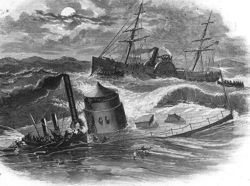Monitor (warship): Difference between revisions
imported>Howard C. Berkowitz No edit summary |
mNo edit summary |
||
| (2 intermediate revisions by 2 users not shown) | |||
| Line 1: | Line 1: | ||
{{subpages}} | {{subpages}} | ||
[[Image:USS Monitor.jpg| | [[Image:USS Monitor.jpg|thumb|right|250px|The Ericsson steel-clad ''Monitor'', underway.]] | ||
Giving the type its name, the ''''' | [[Image:The Wreck of the USS Monitor.jpg|thumb|right|250px|{{The Wreck of the USS Monitor.jpg/credit}}<br />A depiction of the ironclad [[USS Monitor|USS ''Monitor'']] sinking in a storm off [[Cape Hatteras]] on the night of December 30-31, 1862.]] | ||
Giving the type its name, the '''USS ''Monitor''''' was an 1862 [[United States Navy]] warship that made its debut at the [[Battle of Hampton Roads]] against the ironclad but [[broadside (gunnery)]]-oriented ship [[CSS Virginia|CSS ''Virginia'']]. ''Monitor'', designed by [[John Dahlgren]], was a full technological generation beyond the advanced ''Virginia'' that had appeared the day before, but the monitor type was still very much a prototype. | |||
'' | The ''Monitor'', derisively called the "cheese box on a raft," had a very low deck over which waves washed, a small pilothouse, and a central, heavily armored turret containing two 11" guns and being able to rotate 360 degrees. She was slow and barely seaworthy, certainly unable to go outside coastal waters. The basic design, however, proved valuable in the [[American Civil War]], and many more, some with two turrets, were built, mostly for river and harbor combat. As seaworthy armored [[battleship]] designs emerged, monitors generally fell out of use. There were a few exceptions with extended life, used for shore bombardment, such as HMS ''Roberts'', with a pair of 18" guns, built in [[World War I]] and briefly used in [[World War II]].[[Category:Suggestion Bot Tag]] | ||
The basic design, however, proved valuable in the [[American Civil War]], and many more, some with two turrets, were built, mostly for river and harbor combat. As | |||
Latest revision as of 16:01, 20 September 2024

A depiction of the ironclad USS Monitor sinking in a storm off Cape Hatteras on the night of December 30-31, 1862.
Giving the type its name, the USS Monitor was an 1862 United States Navy warship that made its debut at the Battle of Hampton Roads against the ironclad but broadside (gunnery)-oriented ship CSS Virginia. Monitor, designed by John Dahlgren, was a full technological generation beyond the advanced Virginia that had appeared the day before, but the monitor type was still very much a prototype.
The Monitor, derisively called the "cheese box on a raft," had a very low deck over which waves washed, a small pilothouse, and a central, heavily armored turret containing two 11" guns and being able to rotate 360 degrees. She was slow and barely seaworthy, certainly unable to go outside coastal waters. The basic design, however, proved valuable in the American Civil War, and many more, some with two turrets, were built, mostly for river and harbor combat. As seaworthy armored battleship designs emerged, monitors generally fell out of use. There were a few exceptions with extended life, used for shore bombardment, such as HMS Roberts, with a pair of 18" guns, built in World War I and briefly used in World War II.
